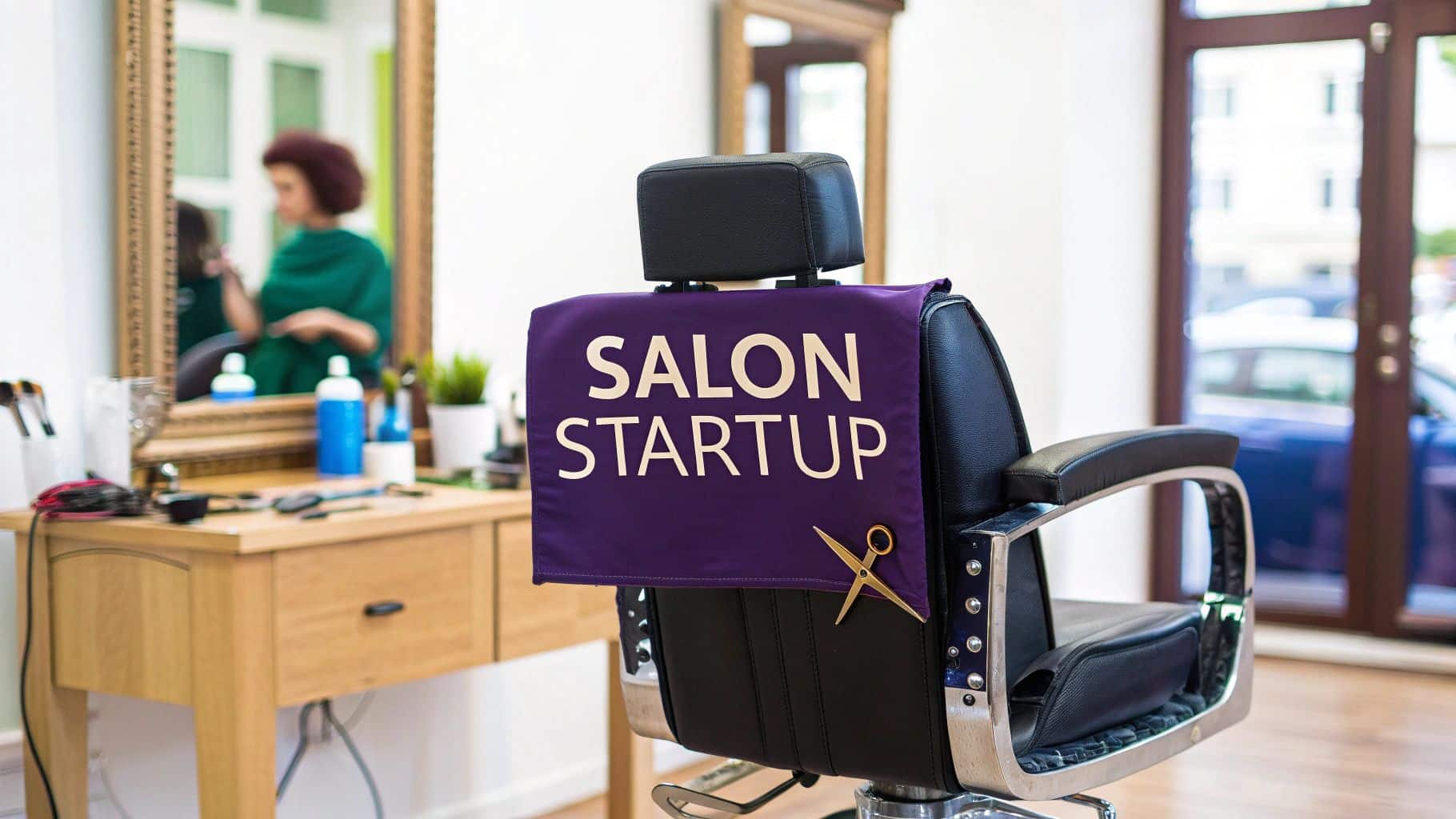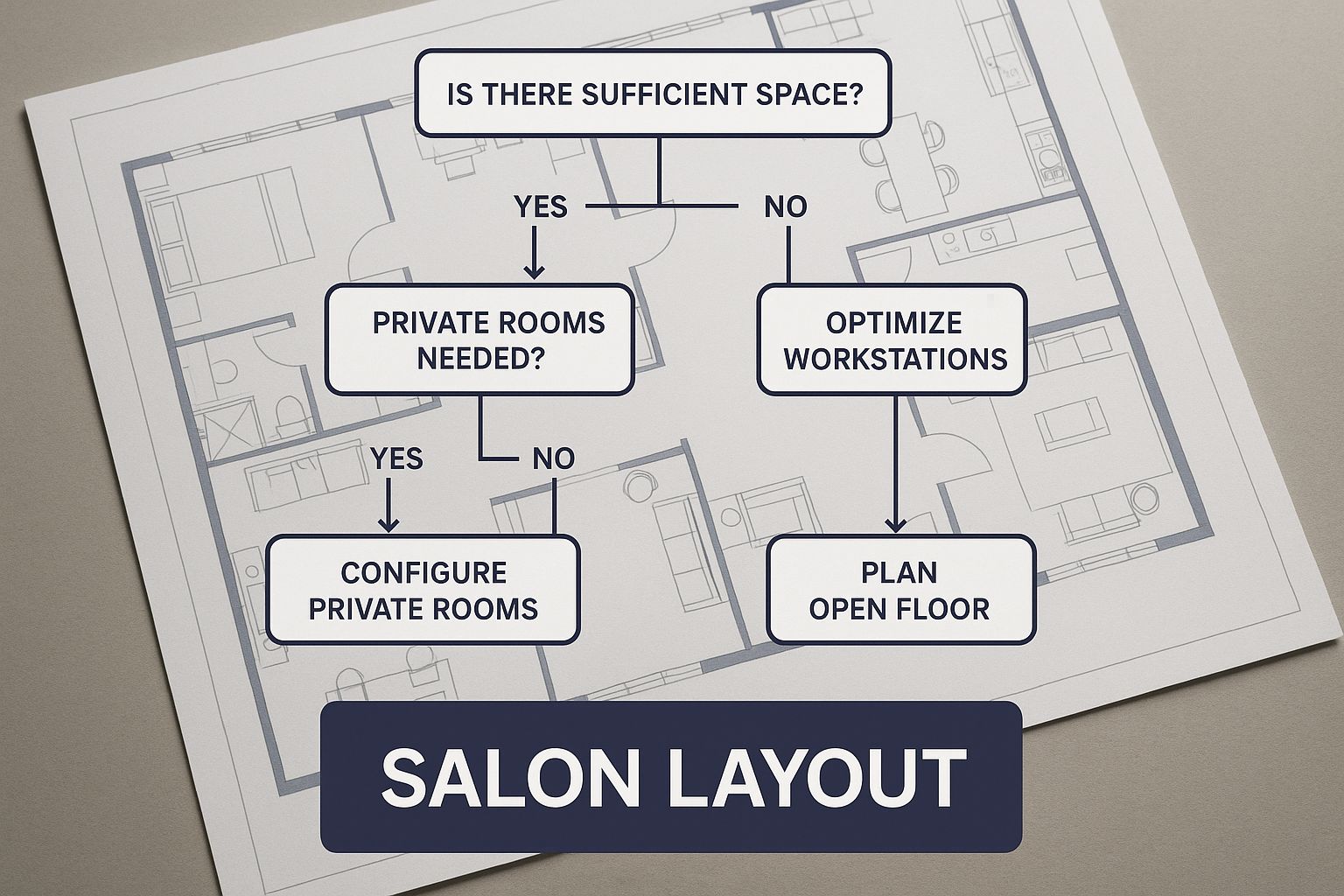Starting a Hair Salon: An Actionable Guide

Before you pick out the perfect styling chairs or that gorgeous shade of paint, you need to lay the groundwork for your salon. This initial planning stage is like drawing up the blueprints for your dream business. Getting this part right will save you significant headaches and money down the road. This guide provides easy-to-follow instructions and actionable insights to help you launch successfully.
Crafting Your Salon's Foundation for Success

The great news? You’re jumping into a booming industry. The global salon services market is expected to hit USD 232.6 billion in 2025 and is projected to nearly double to a staggering USD 429.8 billion by 2035.
This growth means opportunity, but it also demands a smart, strategic approach to stand out. Here's how to build a solid foundation.
Step 1: Find Your Niche Through Market Research
To succeed, you must become an expert on your local market. It's time to dig into what your specific community wants and needs from a hair salon.
Actionable Steps:
- Analyze Competitors: Create a spreadsheet of local salons. Visit them or browse their websites and social media. Document their services, pricing, salon atmosphere, and read their online reviews. The goal is to identify what they do well and where there are gaps in the market. For instance, you might find a lack of salons specializing in curly hair or high-end color services. That's your potential niche.
- Dig into Local Demographics: Use free resources like your local government's website or census data to understand the age, income levels, and lifestyles in your target neighborhoods. This data will tell you if the population can support your salon concept.
- Survey Potential Clients: Use a free tool like Google Forms to create a short survey. Post it in local community Facebook groups. Ask direct questions: "What salon services do you wish were available in our area?" and "What is the most important factor for you when choosing a salon?"
- Become a Social Media Detective: Search local hashtags on Instagram (e.g., #AustinHair, #ChicagoStylist) to see what styles are trending and what services people are asking for.
Step 2: Define Your Unique Brand Identity
Your brand is more than a logo; it's the entire experience you offer. It's the feeling clients get when they walk in and what makes them choose you. Use your market research to build a brand that fills a specific need.
Actionable Steps:
- Choose Your Vibe: Based on your research, decide on your salon's personality. Is it a luxury retreat, a funky modern hub, or a family-friendly spot? This decision will guide every choice you make, from your salon's name to the music you play.
- Craft a Brand Promise: This is a clear statement of what clients can expect every time they visit. For example: "To provide an upscale, relaxing color experience with master stylists who prioritize hair health." This promise builds trust and loyalty.
- Write Your Mission Statement: This is the "why" behind your business. It guides your culture and decisions. For practical tips, use this guide on writing a powerful mission statement for a hair salon.
Step 3: Build an Investor-Ready Business Plan
Your business plan is the roadmap that transforms your ideas into an actionable strategy. It's essential for securing funding and for guiding your decisions during the critical first few years.
Actionable Steps:
- Outline Key Sections: A strong business plan includes an executive summary, company description, market analysis (your research from Step 1), organization and management structure, service and product line, marketing and sales strategy, and financial projections.
- Create Realistic Financial Projections: This is the most critical part. You must get granular. List every anticipated startup cost: lease deposits, renovation, equipment, initial product inventory, licenses, and marketing.
- Project Your Revenue: Forecast your income for the first three years. Be conservative. Factor in a ramp-up period as you build your client base and account for seasonal slow periods. This demonstrates that your vision is not just a dream but a viable business.
Realistic Startup Cost Estimates for a New Salon
This table provides estimated cost ranges for the primary expenses involved in opening a new hair salon, helping you budget effectively.
| Expense Category | Estimated Cost Range (Low End) | Estimated Cost Range (High End) | Key Considerations |
|---|---|---|---|
| Lease Security Deposit | $2,000 | $10,000 | Varies widely based on location, square footage, and local market rates. |
| Renovations & Build-Out | $10,000 | $75,000+ | Depends on the condition of the space. A simple paint job is cheap; major plumbing and electrical work is not. |
| Salon Furniture & Equipment | $15,000 | $50,000 | Styling chairs, wash stations, dryers, reception desk. Buying used can save money, but new comes with warranties. |
| Initial Product Inventory | $5,000 | $20,000 | Includes professional color lines, backbar products, and retail items. Your chosen brand partner will influence this cost. |
| Licenses & Permits | $500 | $2,000 | Business license, cosmetology establishment license, and potentially local permits. |
| Software & POS System | $500 | $3,000 | Booking software, payment processing, and hardware. Subscription models are common. |
| Marketing & Grand Opening | $1,000 | $10,000 | Website, social media ads, signage, and launch event expenses. |
| Initial Legal & Accounting | $1,000 | $5,000 | Fees for setting up your business entity (LLC, etc.) and professional consultations. |
| Contingency Fund | $5,000 | $25,000 | CRITICAL: Always have 3-6 months of operating expenses saved for unexpected costs. |
Remember, these are estimates. Always budget on the higher end to avoid surprises.
Getting Your Salon's Legal and Financial House in Order
With your plan in place, it’s time to tackle the legal and financial steps that make your salon an official business. Breaking this process down into manageable tasks will make it feel less overwhelming.

Handling these details correctly from the start protects you and your business in the long run.
Step 4: Choose the Right Business Structure
Your legal structure affects your taxes, liability, and administrative requirements. The two most common choices for new salon owners are a Sole Proprietorship or a Limited Liability Company (LLC).
- A Sole Proprietorship is the simplest to set up. You and the business are legally the same entity. This means you have full control, but your personal assets (home, car) are at risk if the business incurs debt or is sued.
- An LLC creates a legal separation between your personal assets and your business. This protects you from business liabilities. It requires more paperwork and a filing fee, but the peace of mind is invaluable for most entrepreneurs.
Actionable Insight: For most new salon owners, forming an LLC is the recommended path. The asset protection it offers is a critical safeguard for your personal financial health.
Step 5: Secure the Must-Have Licenses and Permits
You must have all required licenses in place before opening your doors. Requirements vary by state, county, and city.
Actionable Checklist:
- State Cosmetology or Salon License: Contact your state's cosmetology board for application details. This is non-negotiable.
- Business License: Apply at your local city or county clerk's office. This permits you to operate a business in that jurisdiction.
- Certificate of Occupancy: Once you have a location, you'll need to pass an inspection to prove the space is safe and up to code.
- Retail Seller Permit: If you plan to sell products, register with your state's tax agency to collect sales tax.
- Employer Identification Number (EIN): If you will hire employees, apply for this free federal tax ID on the IRS website.
Pro Tip: Create a folder for all your legal documents, both physical and digital. Staying compliant builds credibility and helps you avoid fines. A well-organized nail salon business plan template can also provide a solid structure for organizing this information.
Step 6: Find the Right Funding for Your Salon
Unless you are self-funding, you will need capital to launch. Choosing the right funding is crucial. Start by exploring the essential funding options for startups.
Common Funding Paths:
- Traditional Bank Loans: These often have good interest rates but require a strong business plan, good credit, and often, collateral.
- SBA Loans: Backed by the Small Business Administration, these loans are often more accessible for new entrepreneurs with more flexible terms.
- Equipment Financing: These are loans specifically for purchasing salon equipment, where the equipment itself serves as collateral, making them easier to obtain.
Actionable Insight: Compare the interest rates, repayment terms, and eligibility requirements for each option. The financial partner you choose will play a key role in your salon's early success.
Choosing a Location and Designing Your Salon
. This ensures every service is profitable.
- Price for Value, Not to Compete: With nearly 1.5 million hair and nail salons in the U.S. and an average profit margin of 8.2%, competing on price is a race to the bottom. Charge based on the expertise, experience, and quality you offer. You can learn more about these industry benchmarks.
- Implement Tiered Pricing & Packages: Offer services with a "Stylist," "Senior Stylist," or "Master Stylist" at different price points. This provides options for clients and a career path for your team. Bundle services like a "Cut, Color, and Treatment" package to increase the average ticket price.
Your Go-to-Market Plan: Filling Your Chairs from Day One
An empty appointment book is a new owner's biggest fear. A smart, proactive marketing plan will build buzz and turn your grand opening into a launchpad for a fully booked schedule.
Step 13: Nail Your Digital First Impression
Before visiting, potential clients will look you up online. Your website and social media are your digital storefront and must be impeccable.
Actionable Digital To-Do List:
- Invest in High-Quality Visuals: Your salon is beautiful, so show it off! Post bright, professional photos of your interior on your website and social media. As you produce work, get high-quality photos of your best results.
- Curate Your Vibe on Instagram: Use Instagram as a visual portfolio. Share a mix of your work, behind-the-scenes content, and inspirational images that reflect your brand's personality.
- Engage with Your Local Community Online: Follow and interact with other local businesses, influencers, and community pages. A simple comment or "like" can put you on their radar.
Step 14: Dominate the "Near Me" Search
When someone searches "hair salon near me," you need to appear at the top. This is accomplished through local Search Engine Optimization (SEO).
Actionable Step: Claim and fully optimize your Google Business Profile. This is the single most important local marketing action you can take. Fill out every single field: address, phone number, hours, and website. Upload at least 10 high-quality photos. Then, encourage your first clients to leave reviews. A stunning 98% of consumers read online reviews for local businesses.
Your Google Business Profile is the new Yellow Pages, but a million times more powerful. It’s free, it works, and it’s often the final nudge that makes a new client choose you over the salon down the street.
Make sure your salon's name, address, and phone number are listed identically across all online platforms (Yelp, Facebook, etc.) to build trust with Google.
Step 15: Throw a Grand Opening That Gets People Talking
Your grand opening is a major marketing event designed to create a wave of local buzz and get potential clients into your space.
Actionable Grand Opening Ideas:
- Partner with Neighboring Businesses: Collaborate with the boutique or coffee shop next door to cross-promote the event to both of your audiences and double your reach.
- Create an Irresistible Launch Offer: Offer a time-sensitive deal for attendees, such as 25% off their first service if they book at the event. This builds immediate momentum for your appointment book.
- Set up an "Instagrammable" Moment: Create a selfie station with good lighting and a backdrop featuring your salon's logo. Encourage guests to post and tag your salon for a chance to win a prize. This generates free user-generated content and marketing. To amplify your event, learn the basics of Facebook Ads for Small Businesses.
Step 16: Turn First-Timers into Raving Fans
Getting clients in the door is the first step. The key to long-term success is turning them into loyal regulars who refer their friends.
Actionable Retention Strategies:
- Launch a Referral Program Immediately: Keep it simple. For example, when a client refers a new person, they both receive $20 off their next service. This is one of the most cost-effective marketing tactics.
- Actively Ask for Reviews: At the end of a great service, empower your stylists to say, "If you loved your hair today, it would mean the world to us if you could leave a quick review on Google. It really helps a new salon like ours grow."
The salon hair care services market is projected to grow from USD 203.78 billion in 2025 to USD 341.67 billion by 2032. This growth is driven by clients seeking personalized, high-quality experiences. A new salon that markets itself effectively is perfectly positioned to capture a piece of this expanding market. Discover more insights about the salon hair care market on fortunebusinessinsights.com.
Got Questions? We’ve Got Answers.
Starting a salon brings up countless questions. Here are straightforward answers to the most common ones.
What’s a Realistic Startup Cost for a Small Hair Salon?
While costs vary dramatically, a realistic starting budget for a small, modest salon is around $60,000. A high-end salon in a prime location could easily exceed $500,000.
Your largest expenses will be:
- Rent Deposits & Renovations: Securing the lease and performing the build-out (plumbing, electrical) is often the biggest upfront cost.
- Quality Equipment & Inventory: Styling chairs, wash stations, and your initial stock of professional and retail products are a major investment.
- Licenses & Grand Opening Buzz: Don’t forget the administrative fees and a dedicated budget to market your launch effectively.
Actionable Advice: Secure a contingency fund of at least six months' worth of operating expenses. This is your safety net for unexpected costs and will help you get through the initial period of building your client base.
What Are the Most Critical Licenses I Need to Open?
Navigating the legal requirements is essential. While specifics vary, these licenses are nearly universal.
The foundational permits you will need are:
- State Cosmetology or Salon License: The primary license from your state's cosmetology board.
- Local Business License: General permission from your city or county to operate a business.
- Retail Permit: Required to collect sales tax if you sell products.
- Certificate of Occupancy: Proof that your physical location is safe and up to code.
Actionable Step: Call your state's board of cosmetology and your local city hall. They will provide a definitive checklist for your area, removing any guesswork.
Is It Better to Hire Employees or Use a Booth Rental Model?
This decision fundamentally shapes your salon's culture and financial structure. There is no single right answer, only the best one for your business goals.
- Hiring W-2 employees provides maximum control over service quality, client experience, and brand consistency. However, you are responsible for payroll, taxes, and training.
- The 1099 booth rental model results in lower overhead and less daily management. Stylists operate as independent businesses within your salon. The trade-off is less control over brand consistency and salon culture.
Actionable Insight: Most new owners who want to build a strong, cohesive brand start with an employee model to establish their standards and culture from day one.
Building a beautiful, functional website is just as important as designing your physical space. Let the team at gohappybeauty create a stunning, SEO-optimized site that attracts your ideal clients and makes online booking a breeze. Get started with gohappybeauty today!
Grow your beauty business
Our focus is, and always will be, helping you improve your online presence and generate more business from your website. That is what we do, for you.

